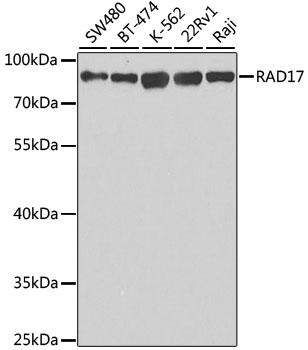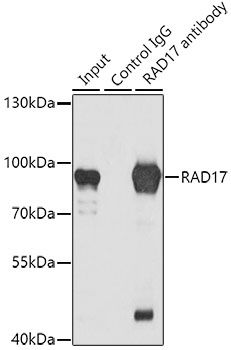Cell Cycle Antibodies 1
Anti-RAD17 Antibody (CAB5359)
- SKU:
- CAB5359
- Product Type:
- Antibody
- Reactivity:
- Human
- Host Species:
- Rabbit
- Isotype:
- IgG
- Antibody Type:
- Polyclonal Antibody
- Research Area:
- Cell Cycle
Description
| Antibody Name: | Anti-RAD17 Antibody |
| Antibody SKU: | CAB5359 |
| Antibody Size: | 20uL, 50uL, 100uL |
| Application: | WB IF IP |
| Reactivity: | Human |
| Host Species: | Rabbit |
| Immunogen: | Recombinant fusion protein containing a sequence corresponding to amino acids 391-670 of human RAD17 (NP_002864.1). |
| Application: | WB IF IP |
| Recommended Dilution: | WB 1:500 - 1:2000 IF 1:10 - 1:100 IP 1:50 - 1:200 |
| Reactivity: | Human |
| Positive Samples: | SW480, BT-474, K-562, 22Rv1, Raji |
| Immunogen: | Recombinant fusion protein containing a sequence corresponding to amino acids 391-670 of human RAD17 (NP_002864.1). |
| Purification Method: | Affinity purification |
| Storage Buffer: | Store at -20'C. Avoid freeze / thaw cycles. Buffer: PBS with 0.02% sodium azide, 50% glycerol, pH7.3. |
| Isotype: | IgG |
| Sequence: | KILY CKRA SLTE LDSP RLPS HLSE YERD TLLV EPEE VVEM SHMP GDLF NLYL HQNY IDFF MEID DIVR ASEF LSFA DILS GDWN TRSL LREY STSI ATRG VMHS NKAR GYAH CQGG GSSF RPLH KPQW FLIN KKYR ENCL AAKA LFPD FCLP ALCL QTQL LPYL ALLT IPMR NQAQ ISFI QDIG RLPL KRHF GRLK MEAL TDRE HGMI DPDS GDEA QLNG GHSA EESL GEPT QATV PETW SLPL SQNS ASEL PASQ PQPF SAQG DMEE NIII EDYE SDGT |
| Gene ID: | 5884 |
| Uniprot: | O75943 |
| Cellular Location: | Nucleus |
| Calculated MW: | 57kDa/66kDa/75kDa/77kDa |
| Observed MW: | 77kDa |
| Synonyms: | RAD17, CCYC, HRAD17, R24L, RAD17SP, RAD24 |
| Background: | The protein encoded by this gene is highly similar to the gene product of Schizosaccharomyces pombe rad17, a cell cycle checkpoint gene required for cell cycle arrest and DNA damage repair in response to DNA damage. This protein shares strong similarity with DNA replication factor C (RFC), and can form a complex with RFCs. This protein binds to chromatin prior to DNA damage and is phosphorylated by the checkpoint kinase ATR following damage. This protein recruits the RAD1-RAD9-HUS1 checkpoint protein complex onto chromatin after DNA damage, which may be required for its phosphorylation. The phosphorylation of this protein is required for the DNA-damage-induced cell cycle G2 arrest, and is thought to be a critical early event during checkpoint signaling in DNA-damaged cells. Multiple alternatively spliced transcript variants of this gene, which encode four distinct protein isoforms, have been reported. Two pseudogenes, located on chromosomes 7 and 13, have been identified. |
| UniProt Protein Function: | RAD17: a cell cycle checkpoint gene required for cell cycle arrest and DNA damage repair in response to DNA damage. Shares strong similarity with DNA replication factor C (RFC), and can form a complex with RFCs. Binds to chromatin prior to DNA damage and is phosphorylated by ATR after the damage. Phosphorylated and activated after DNA damage, inducing cell cycle G2 arrest. Eight alternatively spliced variants have been reported. |
| UniProt Protein Details: | Protein type:Cell cycle regulation Chromosomal Location of Human Ortholog: 5q13 Cellular Component: nucleoplasm; chromosome, telomeric region; nucleus Molecular Function:protein binding; ATP binding Biological Process: regulation of phosphorylation; negative regulation of DNA replication; mitotic cell cycle checkpoint; DNA damage checkpoint; DNA repair; DNA replication; DNA replication checkpoint; response to DNA damage stimulus |
| NCBI Summary: | The protein encoded by this gene is highly similar to the gene product of Schizosaccharomyces pombe rad17, a cell cycle checkpoint gene required for cell cycle arrest and DNA damage repair in response to DNA damage. This protein shares strong similarity with DNA replication factor C (RFC), and can form a complex with RFCs. This protein binds to chromatin prior to DNA damage and is phosphorylated by the checkpoint kinase ATR following damage. This protein recruits the RAD1-RAD9-HUS1 checkpoint protein complex onto chromatin after DNA damage, which may be required for its phosphorylation. The phosphorylation of this protein is required for the DNA-damage-induced cell cycle G2 arrest, and is thought to be a critical early event during checkpoint signaling in DNA-damaged cells. Multiple alternatively spliced transcript variants of this gene, which encode four distinct protein isoforms, have been reported. Two pseudogenes, located on chromosomes 7 and 13, have been identified. [provided by RefSeq, Jul 2013] |
| UniProt Code: | O75943 |
| NCBI GenInfo Identifier: | 62287484 |
| NCBI Gene ID: | 5884 |
| NCBI Accession: | O75943.2 |
| UniProt Secondary Accession: | O75943,O75714, Q7Z3S4, Q9UNK7, Q9UNR7, Q9UNR8, Q9UPF5 A8K8X2, D3DWA5, |
| UniProt Related Accession: | O75943 |
| Molecular Weight: | 681 |
| NCBI Full Name: | Cell cycle checkpoint protein RAD17 |
| NCBI Synonym Full Names: | RAD17 homolog (S. pombe) |
| NCBI Official Symbol: | RAD17 |
| NCBI Official Synonym Symbols: | CCYC; R24L; RAD24; HRAD17; RAD17SP |
| NCBI Protein Information: | cell cycle checkpoint protein RAD17; RAD1 homolog; Rad17-like protein; RF-C activator 1 homolog; RF-C/activator 1 homolog |
| UniProt Protein Name: | Cell cycle checkpoint protein RAD17 |
| UniProt Synonym Protein Names: | RF-C/activator 1 homolog |
| Protein Family: | Checkpoint protein |
| UniProt Gene Name: | RAD17 |
| UniProt Entry Name: | RAD17_HUMAN |
View AllClose









